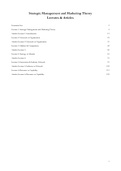Strategic Management and Marketing Theory
Lectures & Articles
Literature List 2
Lecture 1: Strategic Management and Marketing Theory 4
Articles Lecture 1: Introduction 12
Lecture 2: Network or Organization 23
Articles Lecture 2: Network or Organization 31
Lecture 3: Markets & Competition 42
Articles Lecture 3: 50
Lecture 4: Strategy or Identity 63
Articles Lecture 4: 76
Lecture 5: Innovation & Industry Lifecycle 91
Articles Lecture 5: Industry or Lifecycle 102
Lecture 6: Resource or Capability 112
Articles Lecture 6: Resource or Capability 122
1
, Literature List
Week 1 Introduction
Suddaby, R. 2010 Construct Clarity in Theories of Management and Organization Academy of Management Review
Vol. 35, No. 3, 346–357.
Kennedy, M. T. 2008. Getting counted: markets, media, and reality. American Sociological Review 73:270–295.
Baum, J. A., & Shipilov, A. V. (2006). 1.2 Ecological Approaches to Organizations. The Sage handbook of
organization studies, 55.
Kuijken, B. Gemser, G., & Wijnberg, (2016) Effective Product Service Systems: a Value-Based Framework,
Industrial Marketing Management
Week 2 Organization or Network
Simon, Herbert A. (1991) Organizations and markets, Journal of Economic Perspectives, vol 7, no2, 23-44
Kogut, B (2000) “The Network as Knowledge: generative Rules and the Emergence of Structure”, Strategic
Management journal, Vol. 21, 405-425.
Uzzi, B., and J. Spiro 2005 "Collaboration and creativity: The small world problem." American Journal of Sociology,
111: 447-504.
Ebbers, J.J. & Wijnberg, N.M. (2009). Latent Organizations in the Film Industry: Contracts, Rewards, and
Resources. Human Relations. 62(7): 987–1009.
Week 3 Competition or Market
Jia, R., Lewis, D., & Negro, G. (2022). Collaborations and Innovation in Partitioned Industries: An Analysis of
US Feature Film Coproductions. Organization Science. (in Press)
Hitters, E. & Kamp, M. van der (2010) Tune in, fade out: Music companies and the classification of domestic
music products in the Netherlands Poetics 38, 461–480
Mol, J.M., Wijnberg, N.M. & Carroll, C. (2005) “Value Chain Envy: Explaining New Entry and Vertical
Integration in Popular Music”, Journal of Management Studies, 42, 2, 251-276
Rindova, V., Becerra, M., & Contrado, I. (2004). Enacting competitive wars: Actions, Language Games, and
Market Consequences. Academy of Management Review, 29, 4, 670-686.
Week 4 Strategy or Identity
Ghoshal, Sumantra and Moran, Peter (1996) “Bad for Practice: A Critique of the Transaction Cost Theory”.
Academy of Management Review 21/1: 13-47.
Phelan, S.E and Lewin, P (2000) Arriving at a Strategic Theory of the Firm, International Journal of
Management reviews, vol. 2, no 4, 305-323.
Kanter, Rosabeth Moss (2002) “Strategy as Improvisational Theatre”, MIT Sloan Management Review, Vol 43,
no 2, 76-82. (PDF on Canvas page, see module of this week)
Seong, S., & Godart, F. C. (2018). Influencing the influencers: diversification, semantic strategies, and creativity
evaluations. Academy of Management Journal, 61(3), 966-993.
Glynn, M.A. and Abzug, R. (2002) “Institutionalizing identity: Symbolic Isomorphism and Organizational
Names” , Academy of Management Journal, vol 45, no.1, 267-280.
2
,Week 5 Innovation or Industry Life Cycle
Suarez, Fernando F., Stine Grodal, and Aleksios Gotsopoulos. (2015) "Perfect timing? Dominant category,
dominant design, and the window of opportunity for firm entry." Strategic Management Journal 36.3:
437-448.
Fayard A-L, Stigliani I, Bechky BA. (2017) How Nascent Occupations Construct a Mandate: The Case of Service
Designers’ Ethos. Administrative Science Quarterly. 2017;62(2):270-303
Reid, S.E. and De Brentani, U. (2004) “The Fuzzy Front End of New Product Development for Discontinuous
Innovation: A Theoretical Model”, Journal of product innovation Management, Vol. 21, 170-184.
Wijnberg, N.M. (2004) “Innovation and Organization: Value and Competition in Selection Systems”, Organization
Studies, Vol. 25, No. 8, pp. 1469-1490.
Week 6 Resource or Capability
Miller, D. and Shamsie, J. (1996) A Resource-Based View of the Firm in two Environments: The Hollywood
Film Studios from 1936 to 1965, Academy of management Journal, Vol. 39, no. 3, 519-543.
Shamsie, J., Martin, X., & Miller, D. (2009). In with the old, in with the new: Capabilities, strategies, and
performance among the Hollywood studios. Strategic Management Journal, 30(13), 1440-1452.
Arend RJ, Bromiley P. 2009. Assessing the dynamic capabilities view: spare change, everyone? Strategic
Organization 7(1): 75–90.
Mol, J.M. and Wijnberg, N.M. (2011) From Resources to Value and Back: Competition Between and Within
Organizations, British Journal of Management, 22, 1: 77-95.
Boyd, B. K., Bergh, D. D., & Ketchen, D. J. (2010). Reconsidering the reputation—performance relationship: A
resource-based view. Journal of Management, 36(3), 588-609.
3
, Lecture 1: Strategic Management and Marketing Theory
- Week 1: Mr. Wijnberg
- Every production in the CI contains minor innovations -> more challenging to define what an innovation is
- 5 main pairs of concepts:
- L2: Organization or Network
- L3: Competition or Market
- L4: Strategy or Identity
- L5: Innovation or Industry Life Cycle
- L6: Resource or Capability
Two Core Meta-Objectives of the Course
1) Fundamentalism:
- Getting back to basics
- Applying as generally as possible
2) Harassment:
- Operationalizing wherever possible
- Creating real intimacy between concepts
Article 1: Construct Clarity in Theories of Management and Organization (Suddaby, 2010)
- Topic: concept clarity in management science and scope conditions. How to define something. This is
necessary for understanding and testing the theory.
- Article emphasizes the importance of carefully defining concepts and theorizing, because of its implications
on real life. Management concerns can often be rooted back to individuals holding different definitions about
the same concepts, thereby causing disagreements and misunderstandings.
- Understand how useful theoretical frameworks are -> good for well operationalized concepts
- Most debates are won by being able to redefine the core concepts in a way which benefits the evidence you
may have
- So good concepts/constructs are useful for practice:
- To make and execute your own plans
- To defend your own plan & defeat others people’s proposals
Good Definitions
- Definitions, not descriptions
- Not too narrow, not missing “important” characteristics
- Not too broad, not including unrelated matters (let alone counterexamples)
- Making use of unambiguous terminology (or terminology you can define as well)
- “Scope conditions”
- Relationships between concepts
4




